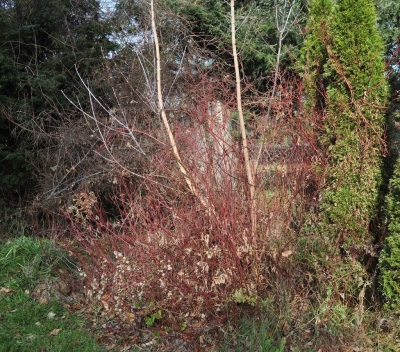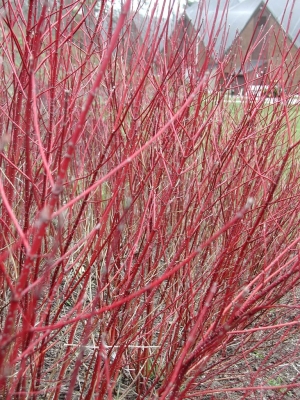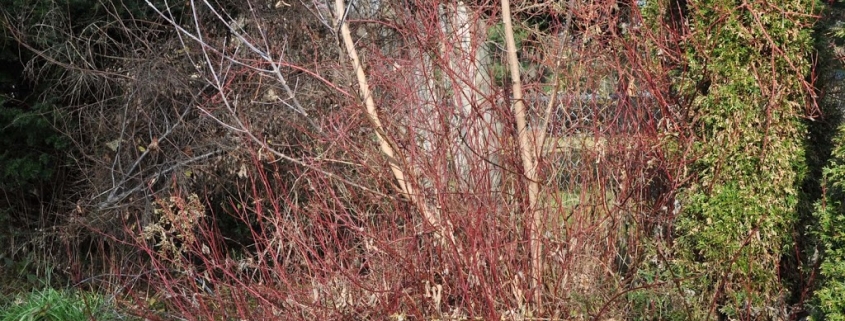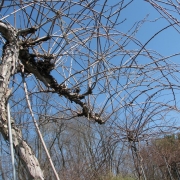PRUNING, I CAN’T RESIST
Now is generally not a good time for pruning outdoor plants. Too bad. With the lawn nicely trimmed and vegetable and flower beds tidied up, it’s all the more difficult to resist the urge to lop back at least some misplaced or congested stems on trees, shrubs, and vines.
 |
| Redosier dogwood, neglected |
I can’t resist. I figure little or no harm should come as long as I choose carefully what to cut. One reason not to prune now is that any wounding — and pruning does wound — stimulates a certain amount of cellular activity near the cut at a time when plants should be hunkering down for winter. Resulting cold injury can be minimized or nonexistent if pruning is restricted to the most cold-hardy plants. Also, gaping wounds won’t heal until spring so are open to pests. Here I rationalize that problems will be, again, minimal or nonexistent if only naturally tough plants are pruned now.
I’ve been eyeing an ungainly redosier dogwood since leaves have dropped. Redosiers are super-hardy, shrubby plants that liven up the winter scene with their bright red or yellow stems. The time to prune these plants is in early spring, after enjoying the plant’s colorful stems all winter.
The problem is that my redosier dogwood has been neglected for years. Only the one-year old stems are colorful and, with years of neglect, few are evident amongst the older wood. The right way to prune this plant is to lop the whole shebang to the ground every year or two in spring. Doing so coaxes a slew of vigorous, new sprouts near or just below ground level. Come autumn, these sprouts are officially one-year old (that is, they’ve completed a whole season of growth) and need only crisp weather to bring out their brightest color.
I’m lopping my whole plant to the ground this week (in addition to the boxelder and other weedy plants that have sprouted up among it). The plant is very hardy, has nothing to show for winter, and pruning now leaves one less thing to do in spring.
 |
| Black & red currants, pruned |
Likewise very cold-hardy and likewise soon to feel the steel of my pruning shears are my currant and gooseberry plants. Gooseberries and red currants bear fruit on one-, two-, and three-year-old stems so I’ll be cutting down any stems older than three-years-old and thinning out the youngest stems so that they don’t crowd as they age. Black currants fruit best on one-year-old stems so I’ll cut down any stems that bore fruit this past summer and thin out young stems if they crowd too much. All these plants start growth very early in spring, which is one more reason to prune them now.
————————————————
 |
| Redosier dogwood, pruned & very red |
Stems don’t speak to me or bear age labels, so how do I know which ones are one- or two-years-old, or older? I look at them. With some plants, it’s very easy to tell. As I wrote, only the very youngest redosier dogwood stems turn red or yellow, with the help of cold weather. Kerria, also known as Japanese rose, blooms best on one-year-old wood, which broadcasts its age with its bright, green color; older stems are brown.
Other plants’ stems offer hints of their age even if they don’t colorfully broadcast it. Oldest stems generally are those that are the thickest. Stems also show their age in bark that starts to peel or gets bumpy or warty; that is, it looks old.
————————————————-
I’m not yet finished cutting. Lanky stems lash out and grab me as I pass across my terrace beneath the grape arbor, or walk down the field near the trellised kiwi vines. I’d like to prune them now, and I will, to some degree at least.
Kiwi expert Dave Jackson, who grows some of the best hardy kiwifruits I’ve ever tasted (www.kiwiberry.com), has 20 acres of the plants. He tells me that he prunes in autumn with no ill effect, so I’m tempted to do so also. Kiwis require more pruning that most plants and one reason he prunes in autumn could be because he wouldn’t have time to prune everything if he waited until spring.
Temperatures and airflow here at my farmden are not nearly as congenial for the plants as at Dave’s farm, which makes me wary of pruning my vines now. So I’ll prune a couple of my kiwi vines now and see how they fare. The rest will get pruned in spring.
But I’m going to shorten lanky stems on all the kiwi plants, as well as those on my grapes. Plants pack away food for winter in stems, so cutting stems does remove some winter stores; still, many stems, trunks, and roots will be left intact. Right near pruning cuts is where plants are most susceptible to damage. Shortening stems partially, rather than to their full length, avoids problems near the cuts. Final cuts can wait until spring.
————————————————-
Some plants needn’t feel even slightly threatened by my pruning shears — now, at least. Pruning butterfly bush in autumn, in my experience and that of many other gardeners, results in increased winter cold injury. Come spring, though, all their stems get lopped to the ground. I also won’t touch spring bloomers, such as lilac, forsythia, and mockorange bushes. Pruning would remove stems slated to bloom this spring. The time to prune these plants is right after they finish their flowery shows.
Want more on pruning? See my book, The Pruning Book (Taunton Press, 2010).






You mentioned boxelders there. Have you found any beneficial uses for that tree? The yard of the home I just bought is absolutely full of boxelder trees, seedlings, old stumps, etc. It’s everywhere trying to repair the soil I guess (The soil is super gravelly.
As I systematically start getting rid of them, is there anything that should motivate me to hang on to a few?
Boxelders are pretty much weed trees. They grow fast, have weak wood, and no fall color. I’d cut them down. I have made maple syrup from them and it tasted okay. Boxelders are in the same genus, Acer, as sugar maples.
The recent warm weather makes me want to get outside, too. In Madison, WI it will be close to 60 degrees F on Sunday. After cleaning up the yard and covering my strawberries and roses, I’ll be pruning my currants!
Sometimes you’ve just got to do it when you have the time. Now you can use the most colorful stems for your windowboxes. Win, win.